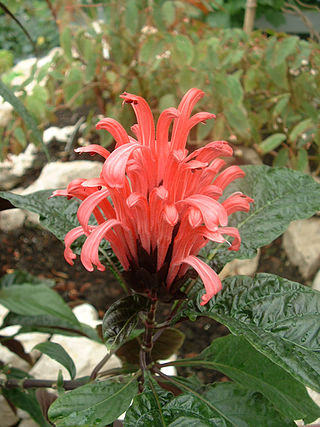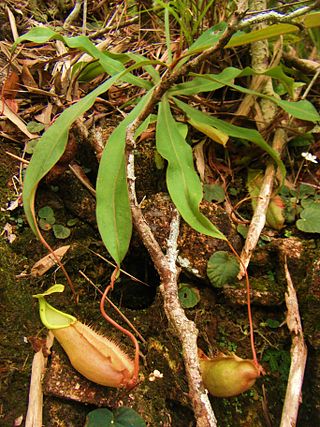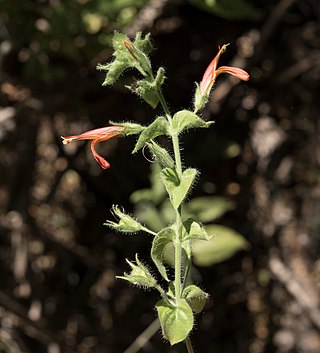
Justicia brandegeeana, the Mexican shrimp plant, shrimp plant or false hop, is an evergreen shrub in the genus Justicia of the acanthus family Acanthaceae, native to Mexico, and also naturalized in Florida.

Acanthaceae is a family of dicotyledonous flowering plants containing almost 250 genera and about 2500 species. Most are tropical herbs, shrubs, or twining vines; some are epiphytes. Only a few species are distributed in temperate regions. The four main centres of distribution are Indonesia and Malaysia, Africa, Brazil, and Central America. Representatives of the family can be found in nearly every habitat, including dense or open forests, scrublands, wet fields and valleys, sea coast and marine areas, swamps, and mangrove forests.

The green hermit is a large hummingbird that is a resident breeder from southern Central America south to northern South America

Conocarpus erectus, commonly called buttonwood or button mangrove, is a species of mangrove shrub in the family Combretaceae.

Justicia is a genus of flowering plants in the family Acanthaceae. It is the largest genus within the family, with over 900 accepted species. They are native to tropical to warm temperate regions of the Americas, India, and Africa. The genus serves as host to many butterfly species, such as Anartia fatima. Common names include water-willow and shrimp plant, the latter from the inflorescences, which resemble a shrimp in some species. The generic name honours Scottish horticulturist James Justice (1698–1763). They are closely related to Pachystachys.

Pachypodium ambongense is a species of plant in the family Apocynaceae. It was first published as a species of the genus Pachypodium in 1924 by the botanist Henri Louis Poisson.

Pachypodium brevicaule is a species of plant that belongs to the family Apocynaceae.

Banksia grossa is a species of shrub in the family Proteaceae and is endemic to Southwest Australia. It is one of fourteen species of banksia of the series Abietinae, all of which bear predominantly cylindrical or oval inflorescences. Collected in 1965, it was first formally described in 1981 by Alex George. Its thick leaves and large seeds distinguish it from other members of the Abietinae, and are the basis of its species name.

Justicia floribunda is a species of flowering plant in the acanthus family Acanthaceae, native to southern Brazil, Paraguay, and Misiones Province of northeastern Argentina.

Terminalia chebula, commonly known as black- or chebulic myrobalan, is a species of Terminalia, native to South Asia from Pakistan, India and Nepal east to southwest China (Yunnan), and south to Sri Lanka, Malaysia, and Vietnam.

Dianthera americana, the American water-willow, is a herbaceous, aquatic flowering plant in the family Acanthaceae native to North America. It is the hardiest species in the genus Dianthera, the other members of which being largely tropical and subtropical, and it is able to survive as far north as USDA zone 4. It is common throughout its range.

Brunfelsia pauciflora is a species of flowering plant in the family Solanaceae, the nightshades. It is endemic to Brazil, and it is grown in cultivation. A shrubby perennial plant grown in gardens, its common names include today, tomorrow together, yesterday, today and tomorrow, morning-noon-and-night, kiss me quick, and Brazil raintree.
Justicia flaviflora is a species of herbaceous plant in the family Acanthaceae. It was previously classified as Beloperone flaviflora. The species is endemic to the island of Trinidad in the Caribbean republic of Trinidad and Tobago where it is only known from near the peaks of mountains in the Northern Range. It is an erect herb with leaves up to 27 cm (11 in) long. It is suffering from habitat degradation and has become increasingly rare, being now rated as "critically endangered".

Nepenthes chang is a tropical pitcher plant endemic to the Banthad Mountains of central Thailand, where it grows at elevations of 300–600 m above sea level. It is thought to be most closely related to N. kampotiana.

Brunfelsia latifolia, commonly known as yesterday-today-tomorrow and kiss me quick, is a species of flowering plant in the nightshade family. Endemic to Brazil, it is an evergreen shrub that becomes semi-deciduous in cooler areas and grows up to 1.8 meters in height.

Justicia gendarussa, commonly known as willow-leaved justicia ,Lapsulis in Creole Seychelles; is a small erect, branched shrub. According to Plants of the World Online it is native to the Indian subcontinent, Indochina, Peninsular Malaysia, Sumatra, the Philippines, and New Guinea, and has been introduced to Nepal, the western Himalayas, Pakistan, southern China including Hainan and Taiwan, eastern Africa, and the Mascarene Islands, Comoro Islands, and Seychelles. It has been described as rare and endemic to India, though those claims are at least confusing, in the context of statements that the plant is widely used in various forms for many of its medicinal and insecticidal properties, and that it is a quick-growing, evergreen forest shrub considered to be a native of China and distributed in Sri Lanka, India and Malaysia.
Acanthopale pubescens is a species of the genus Acanthopale of the family Acanthaceae. The species occurs in East and Southern Africa. Acanthopale pubescensis also known as Herayye in Ethiopia.

Encephalartos gratus is a species of cycad that is native to Malawi and Mozambique.

Justicia purpusii is a species of flowering plant in the Acanthus family commonly known as Purpus' hummingbird flower or chuparosa. This shrub is characterized by long orange-red tubular flowers that bloom from November to April. It is endemic to the Cape region of Baja California Sur, Mexico, where it is found growing in tropical deciduous forest and thorn scrub in canyons and along wet slopes. It is similar to its more northern relative adapted to drier climates, Justicia californica. Phylogenetic analysis has shown that both species are closely related and form a clade.

Dianthera incerta is a species of perennial herb in the Acanthus family commonly known as the Cape tube-tongue or chuparrosa. D. incerta is characterized by solitary, pink, two-lipped tubular flowers up to 27 mm (1.1 in) long that emerge from the leaf axils. It is endemic to the Cape region of Baja California Sur, as is the larger, shrubby, red-flowered Justicia purpusii. It is most similar to other species formerly placed in Siphonoglossa, such as Dianthera sessilis of the West Indies and South America.


















